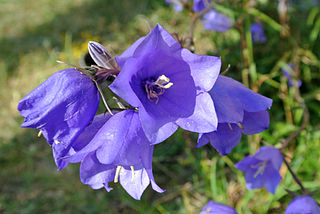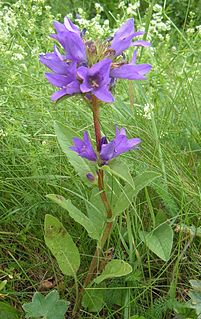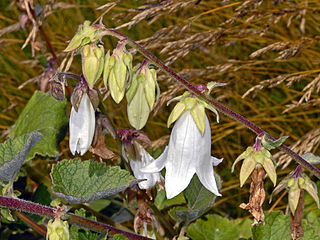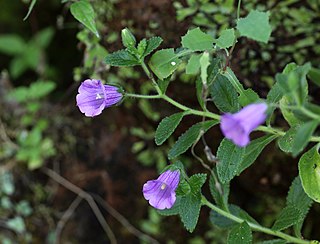
Campanula is one of several genera of flowering plants in the family Campanulaceae commonly known as bellflowers. They take both their common and scientific names from the bell-shaped flowers — campanula is Latin for "little bell".

The family Campanulaceae, of the order Asterales, contains nearly 2400 species in 84 genera of herbaceous plants, shrubs, and rarely small trees, often with milky sap. Among them are several familiar garden plants belonging to the genera Campanula (bellflower), Lobelia, and Platycodon (balloonflower). Campanula rapunculus and Codonopsis lanceolata are eaten as vegetables. Lobelia inflata, L. siphilitica and L. tupa and others have been used as medicinal plants. Campanula rapunculoides may be a troublesome weed, particularly in gardens, while Legousia spp. may occur in arable fields.

Campanula rotundifolia, the harebell, Scottish bluebell, or bluebell of Scotland, is a species of flowering plant in the bellflower family Campanulaceae. This herbaceous perennial is found throughout the temperate regions of the northern hemisphere. In Scotland, it is often known simply as bluebell. It is the floral emblem of Sweden where it is known as small bluebell. It produces its violet-blue, bell-shaped flowers in late summer and autumn.

Campanula glomerata, known by the common names clustered bellflower or Dane's blood, is a species of flowering plant in the genus Campanula, belonging to the family Campanulaceae. It is the county flower of Rutland, England.
Campanula balfourii is a species of flowering plant in the bellflower family Campanulaceae. It is endemic to northeastern Socotra, Yemen. Its natural habitat is subtropical or tropical dry forests.

Helicia is a genus of 110 species of trees and shrubs, constituting part of the plant family Proteaceae. They grow naturally in rainforests throughout tropical South and Southeast Asia, including India, Sri Lanka, Indochina, Peninsular Malaysia to New Guinea and as far south as New South Wales.
Tapeinosperma is a genus of plants in the family Primulaceae. It occurs in Australia, New Guinea, Vanuatu, New Caledonia, Fiji. It is morphologically close to Discocalyx.

The Circumboreal Region in phytogeography is a floristic region within the Holarctic Kingdom in Eurasia and North America, as delineated by such geobotanists as Josias Braun-Blanquet and Armen Takhtajan.

Campanula rapunculus, common name rampion bellflower, rampion, rover bellflower, or rapunzel, is a species of bellflower (Campanula) in the family Campanulaceae.

Campanula gelida is a stenoendemic, critically endangered species of flowering plant in the bellflower family Campanulaceae. It is a perennial species that grows in the mountains of Hrubý Jeseník in the Czech Republic. It evolved through specialization of an isolated population of Campanula scheuchzeri, an Alpine species, which expanded to the area of the Sudetes during a colder period, probably the last ice age. It is closely related to Campanula bohemica, endemic to the Krkonoše Mountains. Sometimes it is even considered its subspecies and referred to as Campanula bohemica subsp. gelida. They all belong to the group of related species Campanula rotundifolia agg.
T. campanula may refer to:

Campanula lanata, the woolly bellflower, is a biennial herb belonging to the family Campanulaceae.

Campanula jacobaea is a species of flowering plants of the Campanulaceae family. The species is endemic to Cape Verde and is listed as vulnerable by the IUCN. Its local name is contra-bruxas-azul. The plant is used in traditional medicine. Campanula jacobaea is shown on a Cape Verdean $5 escudo coin issued in 1994.
Campanula bravensis is a species of flowering plant in the bellfower family Campanulaceae. The species is endemic to Cape Verde. The specific name bravensis refers to the island of Brava. The species was described by Carl August Bolle, and named by Auguste Chevalier in 1935. Its local name is contra-bruxas-branca.

Campanula thyrsoides is a flowering plant belonging to the family Campanulaceae.
Campanula aghrica, the Aghrian bellflower, is a rare flowering plant in the family Campanulaceae. It is native to Turkey and possibly Iran.
Campanula kantschavelii, also known as Kanchaveli's bellflower, is a species of flowering plant in the family Campanulaceae. It is native to Georgia.
Campanula lazica is a species of flowering plant in the bellflower family, Campanulaceae. It is endemic to northeast Anatolia, Turkey.
Campanula seraglio, known as the Serail bellflower, is a species of flowering plant in the family Campanulaceae. It is native to northeastern Turkey.

Campanula troegerae is a species of flowering plant in the bellflower family Campanulaceae. It is native to north-eastern Turkey. It can be found in the provinces of Artvin and Erzurum.












